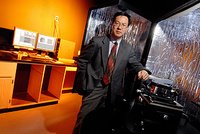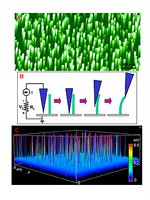Nanogenerators: Researchers Convert Mechanical Energy to Electrical Energy for Self-Powered Nanoscale Devices.
Researchers have developed a new technique for powering nanometer-scale devices without the need for bulky energy sources such as batteries.
 | Georgia Tech Professor Zhong Lin Wang poses in his laboratory. Georgia Tech Photo: Gary Meek, Dowload 300 dpi image. |
Described in the April 14 issue of the journal Science, the nanogenerators produce current by bending and then releasing zinc oxide nanowires – which are both piezoelectric and semiconducting. The research was sponsored by the National Science Foundation (NSF), the NASA Vehicle Systems Program and the Defense Advanced Research Projects Agency (DARPA).
“There is a lot of mechanical energy available in our environment,” said Zhong Lin Wang, a Regents Professor in the School of Materials Science and Engineering at the Georgia Institute of Technology. “Our nanogenerators can convert this mechanical energy to electrical energy. This could potentially open up a lot of possibilities for the future of nanotechnology.”
 | A scanning electron microscope image (top) shows an array of zinc oxide nanowires. Middle image shows a schematic of how an AFM tip was used to bend nanowires to produce current. Bottom image depicts output voltages produce by the array as it is scanned by the probe. Image courtesy of Zhong Lin Wang Dowload 300 dpi image. |
“We can build nanodevices that are very small, but if the complete integrated system must include a large power source, that defeats the purpose,” added Wang, who also holds affiliated faculty positions at Peking University and the National Center for Nanoscience and Technology of China.
The nanogenerators developed by Wang and graduate student Jinhui Song use the very small piezoelectric discharges created when zinc oxide nanowires are bent and then released. By building interconnected arrays containing millions of such wires, Wang believes he can produce enough current to power nanoscale devices.
To study the effect, the researchers grew arrays of zinc oxide nanowires, then used an atomic-force microscope tip to deflect individual wires. As a wire was contacted and deflected by the tip, stretching on one side of the structure and compression on the other side created a charge separation – positive on the stretched side and negative on the compressed side – due to the piezoelectric effect.
The charges were preserved in the nanowire because a Schottky barrier was formed between the AFM tip and the nanowire. The coupling between semiconducting and piezoelectric properties resulted in the charging and discharging process when the tip scanned across the nanowire, Wang explained.
When the tip lost contact with the wire, the strain was released – and the researchers measured an electrical current. After the strain release, the nanowire vibrated through many cycles, but the electrical discharge was measured only at the instant when the strain was released.
To rule out other potential sources of the current, the researchers conducted similar tests using structures that were not piezoelectric or semiconducting. “After a variety of tests, we are confident that what we are seeing is a piezoelectric-induced discharge process,” Wang said.
The researchers grew the nanowire arrays using a standard vapor-liquid-solid process in a small tube furnace. First, gold nanoparticles were deposited onto a sapphire substrate placed in one end of the furnace. An argon carrier gas was then flowed into the furnace as zinc oxide powder was heated. The nanowires grew beneath the gold nanoparticles, which serve as catalysts.
The resulting arrays contained vertically-aligned nanowires that ranged from 200 to 500 nanometers in length and 20 to 40 nanometers in diameter. The wires grew approximately 100 nanometers apart, as determined by the placement of the gold nanoparticles.
A film of zinc oxide also grew between the wires on the substrate surface, creating an electrical connection between the wires. To that conductive substrate, the researchers attached an electrode for measuring current flow.
Though attractive for use inside the body because zinc oxide is non-toxic, the nanogenerators could also be used wherever mechanical energy – hydraulic motion of seawater, wind or the motion of a foot inside a shoe – is available. The nanowires can be grown not only on crystal substrates, but also on polymer-based films. Use of flexible polymer substrates could one day allow portable devices to be powered by the movement of their users.
“You could envision having these nanogenerators in your shoes to produce electricity as you walk,” Wang said. “This could be beneficial to soldiers in the field, who now depend on batteries to power their electrical equipment. As long as the soldiers were moving, they could generate electricity.”
Current could also be produced by placing the nanowire arrays into fields of acoustic or ultrasonic energy. Though they are ceramic materials, the nanowires can bend as much as 50 degrees without breaking.
The next step in the research will be to maximize the power produced by an array of the new nanogenerators. Wang estimates that they can convert as much as 30 percent of the input mechanical energy into electrical energy for a single cycle of vibration. That could allow a nanowire array just 10 microns square to power a single nanoscale device – if all the power generated by the nanowire array can be successfully collected.
“Our bodies are good at converting chemical energy from glucose into the mechanical energy of our muscles,” Wang noted. “These nanogenerators can take that mechanical energy and convert it to electrical energy for powering devices inside the body. This could open up tremendous possibilities for self-powered implantable medical devices.”
RESEARCH NEWS & PUBLICATIONS OFFICE Georgia Institute of Technology 75 Fifth Street, N.W., Suite 100 Atlanta, Georgia 30308 USA , MEDIA RELATIONS CONTACTS: John Toon (404-894-6986); E-mail: (jtoon@gatech.edu) or Jane Sanders (404-894-2214); E-mail: (mailto:kirk.englehardt@gtri.gatech.edu). TECHNICAL CONTACT: Zhong Lin Wang (404-894-8008); E-mail: (zhong.wang@mse.gatech.edu). WRITER: John Toon
Technorati Tags: Nano or Nanotechnology and nanoparticles or Nanotech and Nanopore or nanochemistry and nanoscale or nanowires and nanogenerators or medicine and physics or nanometer and nanostructures or Nanoscience
Related: Keyword Nanotech Sunday, Sunday, April 09, 2006 Nanopore Method Genome Sequencing, Sunday, April 02, 2006 Quantum dot method rapidly identifies bacteria, March 26, 2006 'Custom' nanoparticles, cancer diagnosis and treatment, Sunday, March 26, 2006, Green nanochemistry, American Chemical Society symposium, Sunday, March 19, 2006 nanotechnologists demonstrate artificial muscles powered by highly energetic fuels, Sunday, Sunday, March 12, 2006 magnetic phenomenon may improve RAM memories, February 26, 2006 Nanoscience study shows that quantum dots 'talk', Sunday, February 26, 2006 Nano-bots to undertake major tasks?, Sunday, February 19, 2006 Nanotech to improve health care delivery, Sunday, February 19, 2006 nano-canary in the nanotoxicology coalmine, Sunday, December 04, 2005 Nano-cages 'fill up' with hydrogen, Sunday, November 13, 2005 Testing toxicity of nanomaterials, Sunday, October 23, 2005 single-molecule car, 'Nanocar', Sunday, August 28, 2005 Writing at the nanoscale, Thursday, May 26, 2005 discontinuous palladium, siloxane self-assembled monolayer, Sunday, May 08, 2005 Center for Nanoscale Materials, Monday, April 25, 2005 Nanomagnets, Nanocomposite, Monday, March 21, 2005 porphyrin tubes may lead to new nanodevices, inexpensive hydrogen fuel











No comments:
Post a Comment